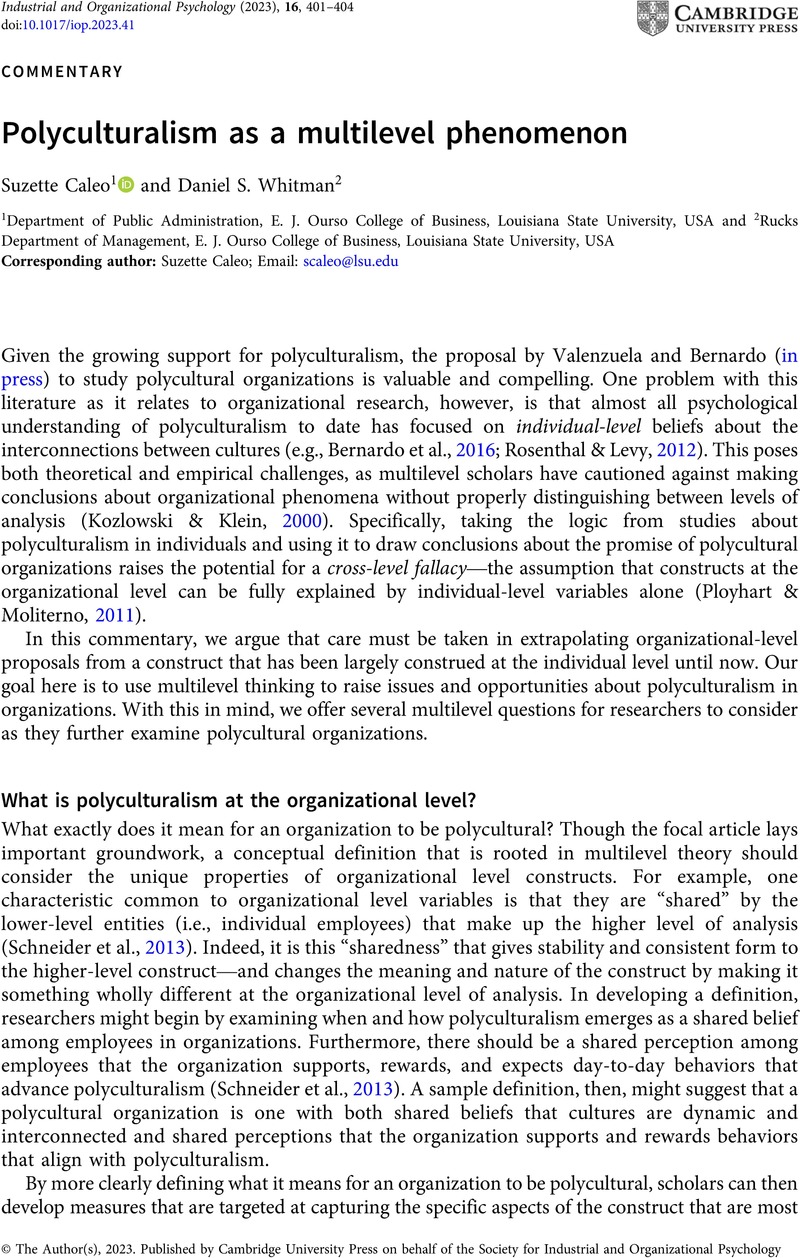No CrossRef data available.
Article contents
Polyculturalism as a multilevel phenomenon
Published online by Cambridge University Press: 31 August 2023
Abstract
An abstract is not available for this content so a preview has been provided. Please use the Get access link above for information on how to access this content.

- Type
- Commentaries
- Information
- Copyright
- © The Author(s), 2023. Published by Cambridge University Press on behalf of the Society for Industrial and Organizational Psychology
References
Aguinis, H., & Molina-Azorin, J. F. (2015). Using multilevel modeling and mixed methods to make theoretical progress in microfoundations for strategy research. Strategic Organization, 13(4), 353–364.CrossRefGoogle Scholar
Bernardo, A. B. I., Salanga, M. G. C., Tjipto, S., Hutapea, B., Yeung, S. S., & Khan, A. (2016). Contrasting lay theories of polyculturalism and multiculturalism: Associations with essentialist beliefs of race in six Asian cultural groups. Cross-Cultural Research: The Journal of Comparative Social Science, 50(3), 231–250. https://doi.org/10.1177/1069397116641895
CrossRefGoogle Scholar
Cho, J., Tadmor, C. T., & Morris, M. W. (2018). Are all diversity ideologies creatively equal? The diverging consequences of colorblindness, multiculturalism, and polyculturalism, Journal of Cross-Cultural Psychology, 49(9), 1376–1401. https://doi.org/10.1177/0022022118793528
CrossRefGoogle Scholar
Healy, E., Thomas, E., & Pedersen, A. (2017). Prejudice, polyculturalism, and the influence of contact and moral exclusion: A comparison of responses toward LGBI, TI, and refugee groups. Journal of Applied Social Psychology, 47(7), 389–399. https://doi.org/10.1111/jasp.12446
CrossRefGoogle Scholar
Kozlowski, S. W. J., Chao, G. T., Grand, J. A., Braun, M. T., & Kuljanin, G. (2013). Advancing multilevel research design: Capturing the dynamics of emergence. Organizational Research Methods, 16(4), 581–615. https://doi.org/10.1177/1094428113493119
CrossRefGoogle Scholar
Kozlowski, S. W. J., & Klein, K. J. (2000). A multilevel approach to theory and research in organizations: Contextual, temporal, and emergent processes. In Klein, K. J. & Kozlowski, S. W. J. (Eds.), Multilevel theory, research, and methods in organizations: Foundations, extensions, and new directions (pp. 3–90). Jossey-Bass.Google Scholar
Ployhart, R. E., & Moliterno, T. P. (2011). Emergence of the human capital resource: A multilevel model. Academy of Management Review, 36(1), 127–150. https://doi.org/10.5465/amr.2009.0318
CrossRefGoogle Scholar
Rosenthal, L., & Levy, S. R. (2012). The relation between polyculturalism and intergroup attitudes among racially and ethnically diverse adults. Cultural Diversity and Ethnic Minority Psychology, 18, 1–16. https://doi.org/10.1037/a0026782
CrossRefGoogle ScholarPubMed
Schneider, B., Ehrhart, M. G., & Macey, W. H. (2013). Organizational climate and culture. Annual Review of Psychology, 64, 361–388. https://doi.org/10.1146/annurev-psych-113011-143809
CrossRefGoogle ScholarPubMed
Valenzuela, M. A., & Bernardo, A. B. I. (in press). The potential of fostering connections: Insights into polycultural organizations. Industrial and Organizational Psychology: Perspectives on Science and Practice 16(3), 378–397.CrossRefGoogle Scholar
van Mierlo, H., Vermunt, J. K., & Rutte, C. G. (2009). Composing group-level constructs from individual-level survey data. Organizational Research Methods, 12(2), 368–392. https://doi.org/10.1177/1094428107309322
CrossRefGoogle Scholar




